This is the second of three articles drawing attention to major structural problems in our history of Europe in the first millennium AD. In the first article (
“How fake is Roman Antiquity?”), we have argued that the forgery of ancient books during the Renaissance was more widespread than usually acknowledged, so that what we think we know about the Roman Empire — including events and individuals of central importance — rests on questionable sources. (We have not claimed that all written sources on the Roman Empire are fake.)
We have also argued that the traditional perspective of the first millennium is distorted by a strong bias in favor of Rome, at the expense of Constantinople. The common representation of the Byzantine Empire as the final phase of the Roman Empire, whose capital had been transferred from the Latium to the Bosphorus, is today recognized as a falsification. Politically, culturally, linguistically, and religiously, Byzantium owes nothing to Rome. “Believing that their own culture was vastly superior to Rome’s, the Greeks were hardly receptive to the influence of Roman civilization,” states a recent
Atlas de l’Empire Romain, mentioning only gladiator combats as a possible, yet marginal, debt.
[1]The assumption that Western civilization originated in Rome, Italy relies partly on a misunderstanding of the word “Roman”. What we now call “the Byzantine Empire” (a term that only became customary in the sixteenth century) was then called Basileía tôn Rhômaíôn (the kingdom of the Romans), and for most of the first millennium, “Roman” simply meant what we understand today as “Byzantine”.
Our perception of Rome as the origin and center of Western civilization is also linked to our assurance that Latin is the mother of all Romance languages. But that filiation, which became a dogma in the mid-nineteenth century,
[2] is under severe attack (we thank the commenters who directed us to
this documentary and
that one, to Yves Cortez’s book
Le Français ne vient pas du latin, and to Mario Alinei’s work). It seems that Dante was correct when he assumed in
De vulgari eloquentia (c. 1303), the first treatise on the subject, that
Latin was an artificial, synthetic language created “by the common consent of many peoples” for written purposes.
[3]The distortions that produced our textbook history of the first millennium have both a geographical and a chronological dimension. The geographical distortion is part of that Eurocentrism that is now being challenged by scholars like James Morris Blaut (The Colonizer’s Model of the World, Guilford Press, 1993), John M. Hobson (The Eastern Origins of Western Civilization, Cambridge UP, 2004), or Jack Goody (The Theft of History, Cambridge UP, 2012). The chronological distortion, on the other hand, is not yet an issue in mainstream academia: historians simply do not question the chronological backbone of the first millennium. They don’t even ask themselves when, how and by whom it was created.
So far, we have formulated the working hypothesis that the Western Roman Empire is, to some extent, a phantom duplicate of the Eastern Roman Empire, conjured by Rome in order to steal the birthright from Constantinople, while concealing its debt to the civilization that it conspired to assassinate. The Roman Empire, in other words, was a dream rather than a memory, exactly like Solomon’s empire. But, one will instantly object, while archeologists have found no trace of Solomon’s empire, the vestiges of Augustus’ empire are plentiful. True, but are these vestiges really from Antiquity, and if so, why are medieval vestiges nowhere to be found in Rome? If Rome was the beating heart of medieval Western Christendom, it should have been busy constructing, not just restoring.
The
Commune of Rome was founded in 1144 as a Republic with a consul and a senate, in the wake of other Italian cities (Pise in 1085, Milano in 1097, Gene in 1099, Florence in 1100). It defined itself by the phrase
senatus populusque romanus (“the Senate and the Roman people”), condensed in the acronym SPQR. Beginning in 1184 and until the early sixteenth century, the city of Rome struck coins with these letters. But, we are told, SPQR was already the mark of the first Roman Republic founded in 509 BC and, more incredibly, it was preserved by emperors, who apparently didn’t mind being thus ignored. As outrageous as it sounds, one cannot easily brush aside the suspicion that the ancient Roman Republic, known to us thanks to Petrarch’s “piecing together” Titus Livy’s
History of Rome,
[4] is an imaginative portrait of late medieval Rome in antique garb. Petrarch was part of a circle of Italian propagandists who celebrated Rome’s past glory. “His intentions,” writes French medievalist Jacques Heers, “were deliberately political, and his approach was part of a real struggle.” He was “one of the most virulent writers of his time, involved in a great quarrel against the papacy of Avignon, and this relentlessness in fighting determined his cultural as well as political options.”
[5]In the first article, we have questioned the objectivity and even the probity of those humanists who claimed to resurrect the long forgotten splendor of Republican and Imperial Rome. In this second article, we turn our attention to ecclesiastical historians of earlier times, who fashioned our vision of Late Antiquity and the Early Middle Ages. Their history of the Christian Church, peopled with miracle-performing holy men and diabolical heretics, is hard to connect with political history, and secular historians specialized in Late Antiquity are generally happy to leave the field to “Church historians” and teachers of faith. That is a shame, because the credibility of this literature has largely gone unchallenged.
The pontifical forgery factory“Arguably the most distinctive feature of the early Christian literature is the degree to which it was forged.” So Bert Ehrman begins his book
Forgery and Counterforgery: The Use of Literary Deceit in Early Christian Polemics. Throughout the first four centuries AD, he says, forgery was the rule in Christian literature, and genuine authorship the exception. Forgery was so systemic that forgeries gave rise to counterforgeries, that is, forgeries “used to counter the views of other forgeries.”
[6] If forgery is part of the DNA of Christianity, we can expect it to continue throughout the Middle Ages.
One of the most famous medieval forgeries is the “Donation of Constantine.” By this document, Emperor Constantine is supposed to have transferred his own authority over the Western regions of the Empire to Pope Sylvester. This forgery of outrageous audacity is the centerpiece of a whole collection of about a hundred counterfeit decrees and acts of Synods, attributed to the earliest popes or other Church dignitaries, and known today as the Pseudo–Isidorian Decretals. Their aim was to set forth precedents for the exercise of sovereign authority of the popes over the universal Church, as well as over kings and emperors.
These documents were not used until the middle of the eleventh century, and it is not before the twelfth century that they were incorporated by Gratian into his
Decretum, which became the basis of all canon law. Yet the scholarly consensus is that they date back from the time of Charlemagne. For that reason, Horst Fuhrmann, a specialist in medieval forgeries, classifies them as “forgeries with anticipatory character,” which “have the characteristic that at the time they were written, they had hardly any effect.” According to him, these fakes had to wait, depending on the case, between 250 and 550 years before being used. Heribert Illig rightly protests against this theory of forgeries allegedly written by clerics who had no immediate use of them and did not know what purpose their forgeries could serve a few centuries later. Forgeries are produced to serve a project, and they are made on demand when needed. The Donation of Constantine and other false Decretals are therefore most probably pure products of the Gregorian reform. Their “anticipatory character” is an illusion created by one of the chronological distortions that we have set out to correct.
[7]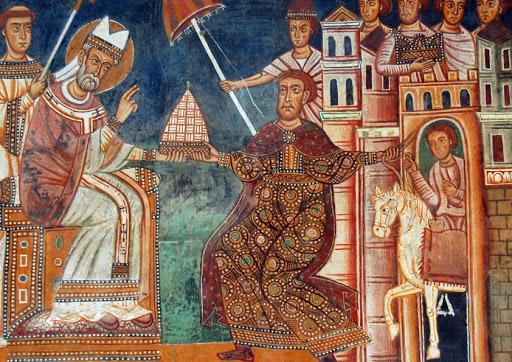
Emperor Constantine’s donation to Pope Sylvester illustrated
The Gregorian reform, which started with the accession of Pope Leo IX in 1049, was a continuation of the monastic revival launched by the powerful Benedictine Abbey of Cluny, which a century after its foundation in 910 had developed a network of more than a thousand monasteries all over Europe.
[8] The Gregorian reform can be conceived as a monkish coup over Europe, in the sense that celibate monks, who used to live at the margin of society, progressively took the leadership over it.
It is worth insisting on the revolutionary character of the Gregorian reform. It was, wrote Marc Bloch in
Feudal Society, “an extraordinarily powerful movement from which, without exaggeration, may be dated the definite formation of Latin Christianity.”
[9] More recently, Robert I. Moore wrote in
The First European Revolution, c. 970-1215: “The ‘reform’ which was embodied in the Gregorian program was nothing less than a project to divide the world, both people and property, into two distinct and autonomous realms, not geographically by socially.” The reform triumphed at the Fourth Lateran Council convoked by Innocent III in 1215. The world created by Lateran IV was “an entirely different world — a world pervaded and increasingly moulded by the well-drilled piety and obedience associated with the traditional vision of ‘the age of faith’, or medieval Christianity.” Yet in a sense, Lateran IV was only a beginning: in 1234, Innocent III’s cousin Gregory IX instituted the Inquisition, but the great period of witch-hunting — the last battle against paganism — was still two centuries away.
[10]In his book
Law and Revolution, the Formation of the Western Legal Tradition (Harvard UP, 1983), Harold Berman also insists on the revolutionary character of the Gregorian reform, by which “the clergy became the first translocal, transtribal, transfeudal, transnational class in Europe to achieve political and legal unity.” “To speak of revolutionary change within the Church of Rome is, of course, to challenge the orthodox (though not the Eastern Orthodox) view that the structure of the Roman Catholic Church is the result of a gradual elaboration of elements that had been present from very early times. This was, indeed, the official view of the Catholic Reformers of the late eleventh and early twelfth centuries: they were only going back, they said, to an earlier tradition that had been betrayed by their immediate predecessors.”
[11] The Reformers, in other words, established a new world order under the pretense of restoring an ancient world order. They created a new past in order to control the future.
For that, they employed an army of legists who elaborated a new canonical legal system to supersede customary feudal laws, and made their new legal system appear as the oldest by producing forgeries on a massive scale. Besides the
Pseudo–Isidorian Decretals and the false Donation of Constantine, they crafted
the Symmachian forgeries, destined to produce legal precedents to immune the pope from criticism. One of these documents, the
Silvestri constitutum, contains the legend of Pope Sylvester 1st curing Constantine the Great of leprosy with the waters of baptism, and receiving in gratitude Constantine’s imperial insignia and the city of Rome. Charlemagne’s father was also made to contribute with the
false Donation of Pepin. It is now admitted that the vast majority of legal documents supposedly established before the ninth century are clerical forgeries. According to French historian Laurent Morelle, “two thirds of the acts entitled in the name of the Merovingian kings (481-751) have been identified as false or falsified.”
[12] It is very likely that the real proportion is much higher, and that many documents which are still deemed authentic are forgeries: for instance, it is our view that the wording of the
foundation charter of the Abbey of Cluny, by which its founder William I (the Pious) renounced all control over it, cannot possibly have been dictated or endorsed by a medieval duke of Aquitaine (virtually a king).
[13]These fake documents served the popes on several fronts. They were used in their power struggle against the German emperors, by backing up their extravagant claim that the pope could depose emperors. They were also powerful weapons in the geopolitical war waged against the Byzantine church and empire. By bestowing on the papacy “supremacy over the four principal sees, Alexandria, Antioch, Jerusalem and Constantinople, as also over all the churches of God in the whole earth,” the false Donation of Constantine justified Rome’s claim for precedence over Constantinople, which led to the Great Schism of 1054 and ultimately the sack of Constantinople by the Latins in 1205. By a cruel irony, the spuriousness of the Donation of Constantine was exposed in 1430, after it had served its purpose. By then, the Eastern Empire had lost all its territories and was reduced to a depopulated city besieged by the Ottomans.
It is little known, but of great importance for understanding medieval times, when ethnicity played a major part in politics, that the Gregorian reformers were Franks, even before Bruno of Egisheim-Dagsburg gave the first impulse as pope Leo IX. That is why Orthodox theologian
John Romanides blames the Franks for having destroyed the unity of Christendom with ethnic and geopolitical motivations.
[14] In Byzantine chronicles, “Latin” and “Frank” are synonymous.
It should now be clear that the very concept of a Gregorian “reform” is a disguise for the revolutionary character of the reformers’ project; “the idea that Gregorians were rigorous traditionalists is a serious oversimplification,” argue John Meyendorff and Aristeides Papadakis; “the conventional conclusion which views the Gregorians as defenders of a consistently uniform tradition is largely fiction.” In fact, before the twelfth century, “the pope’s fragile hold upon Western Christendom was largely imaginary. The parochial world of Roman politics was actually the papacy’s only domain.”
[15] Aviad Kleinberg even argues that, “until the twelfth century, when the pope’s status was imposed as the ultimate religious authority in matters of education and jurisdiction, there was not really an organization that could be called ‘the Church’.”
[16] There certainly were no “popes” in the modern sense before the end of the eighth century: this affectionate title, derived from the Greek
papa, was given to every bishop. Even conventional history speaks of the period of the
“Byzantine papacy,” ending in 752 with the conquest of Italy by the Franks, and teaches that civil, military and even ecclesiastical affairs were then under the supervision of the exarch of Ravenna, the Greek representative of the Byzantine Emperor.
[17]This means that the first-millennium history of the Western Church written by itself is a complete sham. One of its centerpieces, the Liber Pontificalis, a book of biographies of the popes from saint Peter to the ninth century, is today recognized as a work of imagination. It served to ascertain the pope’s claim to occupy the “the throne of saint Peter” in an unbroken chain going back to the first apostle — the “rock” on which Jesus built his kingdom (Matthew 16,18).
As the story goes, in the second year of Claudius, Peter went to Rome to challenge Simon Magus, the father of all heretical sects. He became the first Catholic bishop and was crucified head downwards in the last year of Nero, then buried where St. Peter’s Basilica now stands (his bones were found there in 1968). That story appears in the works of Clement of Rome, the fictional travelling companion and successor of Peter, whose prolific literature in Latin contains so many improbabilities, contradictions and anachronisms that most of it is today recognized as apocryphal and renamed
“pseudo-clementine”. Peter’s story is also the theme of the
Acta Petri, supposedly written in Greek in the second century but surviving only in Latin translation. It is also told by Irenaeus of Lyon (c. 130-202 AD), another author supposedly writing in Greek but known only through defective Latin translations.
There is no reason to take that story as reliable history. It is self-evident propaganda. Moreover, it is inconsistent with the New Testament, which says nothing of Peter’s travel to Rome, and assumes that he simply remained the head of the Jerusalem church. The legend of saint Peter in Rome tells us nothing about real events, but informs us about the means deployed by the Roman curia to steal the birthright from the Eastern Church. It is fake currency minted to overbid on Constantinople’s genuine claim that the unity of the Church had been achieved in its immediate vicinity, at the so-called “ecumenical” councils (Oikouménê designated the civilized world under the authority of the basileus), whose participants were exclusively oriental.
Although we cannot delve here into the editorial history of the New Testament, it is interesting to note that the story of Paul’s travel to Rome also bears the mark of falsification. If we remember that the Byzantines called themselves “Romans”, we are intrigued by the fact that, in his “Epistle to the Romans” (written in Greek), Paul calls the Romans “Greeks” to distinguish them from Jews (1,14-15; 3,9). Moreover, if we look up on a map the cities addressed by Paul in other epistles — Ephesus, Corinth, Galata, Philipae, Thessaloniki (Salonica), Colossae — we see that Italian Rome was not part of his sphere of influence. Paul’s trip to Rome in Italy in Acts 27-28 (where Italy is explicitly named) belongs to the
“we section” of Acts, which is recognizably foreign to the first redaction.
Our main source for the early history of the Church is Eusebius’ Ecclesiastical History in ten volumes. Like so many other sources, it was supposedly written in Greek, but was known in the Middle Ages only in Latin translation (from which it was later translated back into Greek). Its Latin translation was attributed to the great saint and scholar Jerome (Hieronymus). Saint Jerome also produced, at the request of Pope Damasus, the Latin Bible known as the Vulgate, which would be decreed the sole authorized version at the Council of Trent in the mid-sixteenth century.
Eusebius is our main source on the conversion of Constantine to Christianity. Two panegyrics of Constantine have been preserved, and they make no mention of Christianity. Instead, one contains the story of a vision Constantine had of the sun-god Apollo, “with Victory accompanying him.” From then on, Constantine placed himself under the protection of
Sol invictus, also called
Sol pacator on some of his coins.
[18] What Eusebius writes in his
Life of Constantine about the battle of the Milvian Bridge is obviously a rewriting of that earlier pagan legend. When marching on Rome to overthrow Maxentius, Constantine “saw with his own eyes in the heavens a trophy of the cross arising from the light of the sun, carrying the message, ‘by this sign, you shall win’.” The following night, Christ appeared to him in his dream to confirm the vision. Constantine had all his troops paint the sign on their shields and won the battle. Eusebius describes the sign as the Greek letters Chi and Rho superimposed, and tells us it represents the first two letters of
Christos. This
Chi-Rho sign is found in a great variety of mosaic and reliefs up to the time of Justinian, and it is especially common in the Pyrenean region, often with the addition of a sigma, as documented in
this monography.
[19] Some hypothesize that it carried in pagan time the meaning
pax. Whether that is the case or not, there is no evidence that the Chi-Rho was of Christian origin.
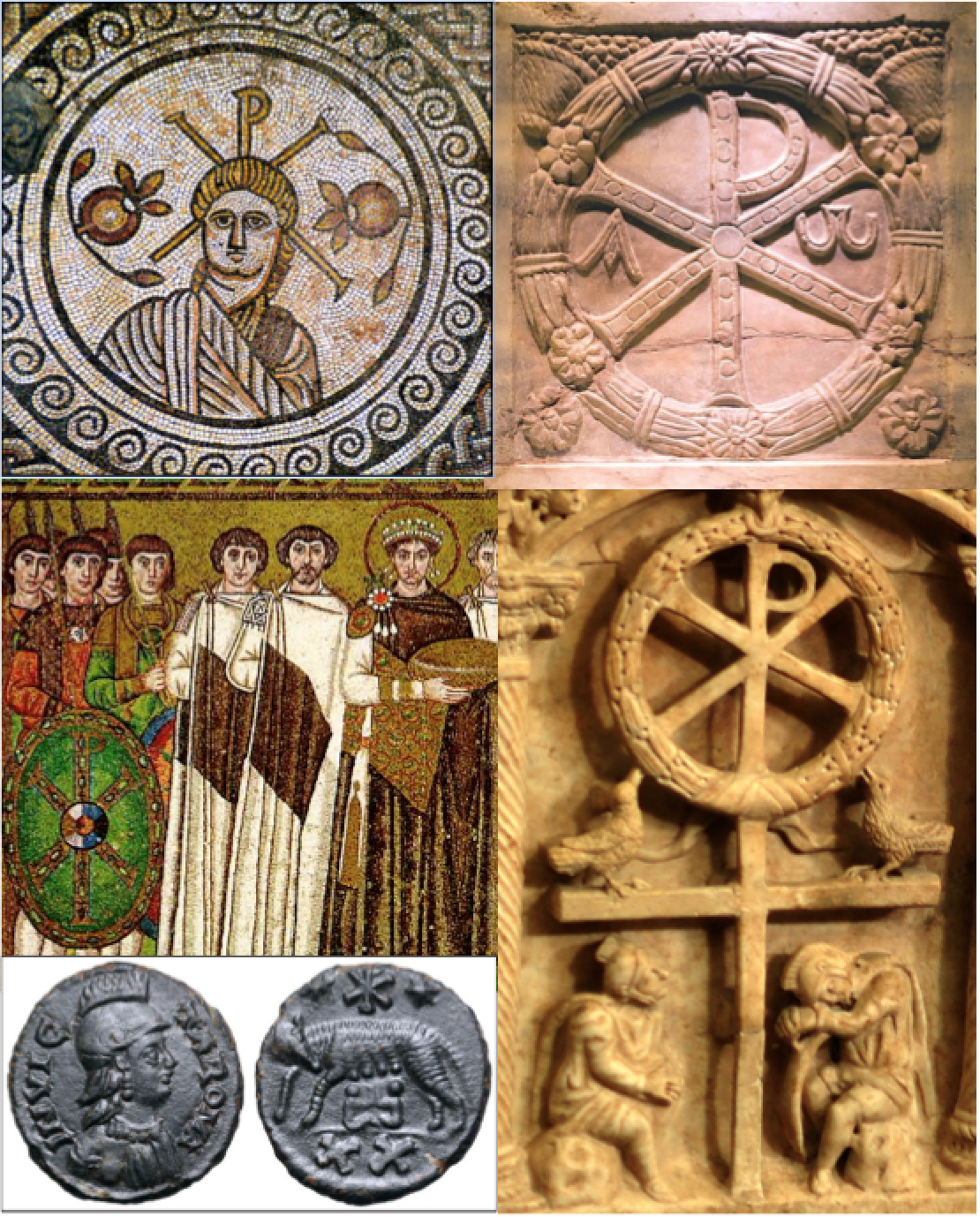
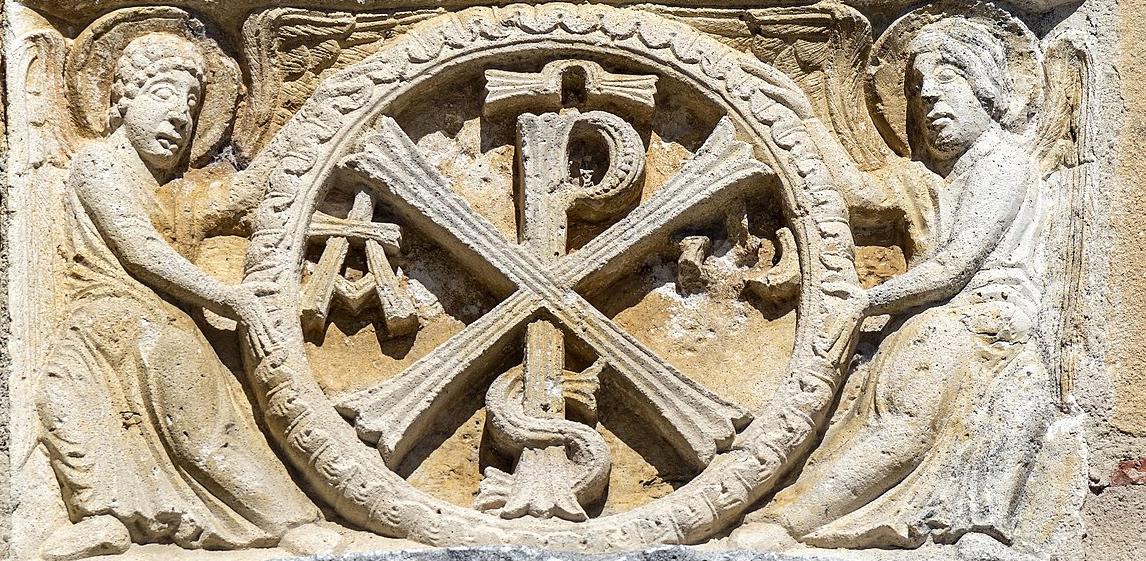
What does Chi-Rho have to do with Christ?
I hope to have shown that there is ample cause for radical skepticism regarding the autobiography of the Roman Church. It is not just legal documents that were forged. The whole underlying narrative could be phony. In the late seventeenth and early eighteenth century, one man, Jesuit librarian
Jean Hardouin (1646-1729), spent a lifetime researching and questioning Church history, until he came to the conclusion of a massive fraud originating in Benedictine monasteries in the thirteenth century. His conclusions were published posthumously in
Ad Censuram Veterum Scriptorum Prolegomena (1766). According to Hardouin, all the works ascribed to Augustine, Jerome, Ambrose of Milan, and Gregory the Great, were in fact written just decades before the cunning Boniface VIII (1294-1303) promoted them as the “Latin Fathers of the Church.” Eusebius’ history translated by Jerome is a web of fiction according to Hardouin.
The Prolegomena of Jean Hardouin were translated in English in the nineteenth century by Edwin Johnson (1842-1901), who built up on Hardouin’s insights in his own works, starting with
The Rise of Christendom (1890), followed one year later by
The Rise of English Culture. Johnson argued for a medieval origin of most literary sources ascribed to Antiquity or Late Antiquity, and insisted that the whole first-millennium history of the Roman Church was fabricated by the Roman curia in its effort to impose its new world order.
The medieval origin of these texts, Johnson says, explains why their supposed authors are fighting heresies that so much resemble the heresies fought by the medieval Church. The Manicheans and Gnostics attacked by Tertullian, Augustine and Irenaeus of Lyon are like the ghosts of those attacked under the same denominations by twelfth and thirteenth-century popes. According to Patricia Stirnemann, the oldest manuscript of Augustine’s
Contra Faustus, written and preserved in the abbey of Clairvaux, is the witness of the struggle against “the resurgence of a neo-manicheism in the 12th century” (she doesn’t question the authorship of the work, but gives us additional reason to do so).
[20]The context of the Latin colonization of the East by the crusaders is transparent in many spurious sources from Late Antiquity, according to Johnson. Jerome’s biography is a case in point: “he is made to travel from Aquileia to Rome, and from Rome to Bethlehem and to Egypt. He settles at Bethlehem, is followed by Roman ladies, who found there a nunnery, and there he dies. This is a reflection of something that was happening during the later Crusades.”
[21] The same goes for Constantine: the legend of his military conquest by the sign of the Crucified bears the mark of the age of the crusades, “when military men came under monkish influence.”
[22]If all first-millennium Church history is bogus, how can we reconstruct the real history of the Church before the Gregorian reform? Johnson says there was no Western Christianity then: the Western Church was “a purely Mediaeval institution, without either literary or oral links with the past,” and its fables “were not heard of in the world until the epoch of the Crusades.”
[23] A less radical hypothesis is that Christianity only became a dominant force in the West with the Gregorian reform. In any case, there is ample evidence that it imposed its religious hegemony not so much by the destruction of pagan traditions as by their appropriation. The cult of Notre Dame, which owes much to Bernard de Clairvaux (1090–1153), was superimposed on cults of Diane and Isis.
What the Gregorian reformers did was rewrite history in order to create the illusion that Christianity was 1000 years old in Europe. Not all sources were written from scratch. Many were simply heavily edited. One example is the
Ecclesiastical History of the English People by Bede the Venerable (672-735). James Watson has shown that it was originally a
History of the English People with no mention of Christianity; it was heavily interpolated during the tenth century, Watson says, when “most of the ecclesiastical notices in the work have been engrafted with the original history.”
[24] A somewhat different case is the Christianization of Boethius (c. 480-524), turned into a Christian theologian and martyr at the time of Abélard, although his famous
Consolation of Philosophy doesn’t contain the slightest mention of his supposed Christian faith.
As for the
History of the Franks, supposedly written at the end of the sixth century by Gregory of Tours, and virtually our only source on Clovis’ conversion to Catholicism, it is most probably a clerical forgery from the Gregorian period, possibly using earlier sources. It is interesting to note that our pseudo-Gregory of Tours (perhaps Odilo of Cluny, who wrote a
Life of Gregory) believed it possible for a medieval power to orchestrate the systematic rewriting of all books: he writes that King Childeric introduced new signs into the Latin alphabet, and “wanted all the old manuscripts to be erased with pumice stone, to make other copies, where the new signs would be used” (chapter IV).
[25]Chroniclers of the eleventh century are important sources for understanding the Christianization of Europe. Thietmar of Merseburg spoke in his Chronicon of a new dawn illuminating the world in 1004, and the French monk Rodulfus Glaber wrote:
“At the approach of the third year after the year 1000, in almost all the earth, especially in Italy and in Gaul, the churches were rebuilt. Although they were in a good state and did not need it, the whole Christian people competed for possession of the most beautiful churches. And it was as if the world itself, shaking the rags of its old age, covered itself on all sides with a white mantle of churches. Then, at the initiative of the faithful, almost all the churches, from the cathedrals to the monasteries dedicated to the various saints, and down to small village oratories, were rebuilt, only more beautifully” (book IV, §13).
[26]
Since Rodulfus writes under Cluniac supervision (he dedicates his work to the abbot of Cluny Odilo), we must be wary of his claim that what appeared new was in fact old, for this was the pretense of the Gregorian “reformers”. Because he says the churches were “in a good state”, their “rebuilding” may be an understatement for their rededication to a new cult. Gregory the Great (590-604), who seems to be a duplicate of Gregory VII, is reported to have recommended that pagan temples be exorcised and reused for Christian worship, and many local traditions in France assert that Romanesque churches were originally pre-Christian sanctuaries.
[27] As for the “basilicas”, their name derives from a Greek word designating a royal building, more precisely a chamber of justice under the authority of the
basileius. Textbook history says that, as the Roman Empire adopted Christianity, the basic architectural plan of the
basilica was adopted for major church buildings throughout Europe, but that explanation has the ring of a flinch.
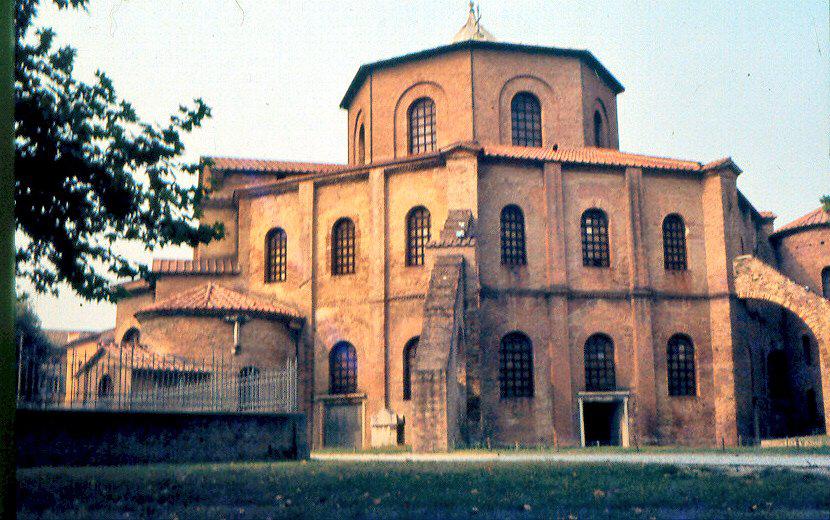
The Byzantine Basilica of San Vitale in Ravenna
In reality, Western Christianity was in its infancy in the year 1000 AD. As for its birth in the East, it is shrouded in mystery, for whatever genuine Greek source could inform us has either been destroyed or heavily edited. The subject is beyond the scope of this article, but let us simply ask: Is it conceivable that the great basilica built by Justinian in the sixth century was dedicated to Christianity and named Hagia Sophia (Holy Wisdom)? Sophia is the goddess of philosophers, not priests, and no “saint Sophie” promoted by Jacques de Voragine in the thirteenth century can hide that fact. Edwin Johnson argued that Christianity and Islam were born in the same period. A case can be made that Hagia Sophia was Christianized during the reign of the iconoclast basileus Leo III the Isaurian (717-741), when it was stripped of all its icons and sculptural work, or in 842, when it was redecorated.
We have now reached a point where one of the working hypotheses of our first article can be reconsidered: although French scholar Polydor Hochart was fully justified to question the prevailing theory that Christian monks copied pagan books on precious parchments,
[28] we must consider the alternative theory that those who copied in the ninth to eleventh centuries the manuscripts that humanists discovered in the fourteenth century were actually not Christians. This will become clearer in our the next.
Where shall we go from here? Assuming that the history of the first millennium is heavily distorted by the forgeries of pontifical scribes and later humanists, can we evaluate the degree of that distortion and reconstruct a credible picture? The best we can do is to position ourselves in the eleventh century, the earliest period for which we have a good amount of chronicles. For that period, we can perhaps trust historians to give us a generally accurate picture of the European, North-African, and Near-Eastern world, and, looking back a couple of centuries away, we can try to discern the movements of history that led to that world. Beyond that, everything is blurry.
Geographically, we might as well position ourselves at the center of the world we are seeking to understand. That center was not Rome. Despite Roman propaganda praising the
Mirabilia Urbis Romae (“the wonders of the city of Rome”) in the tenth and eleventh centuries, the political, economic, cultural and religious center of the civilization that included Rome, was Constantinople (with Alexandria in second position).
In the eleventh century, the walls of Constantinople could have contained the ten largest cities of the West. Its size, architectural masterpieces, and wealth so impressed Western visitors that, in the French novel Partonopeu de Blois, Constantinople is the name of paradise. The economic prosperity of Constantinople rested on its situation at a crossroads of the great trade routes, on a monopoly in the trade of luxury products like silk, on a considerable gold money supply, and on an efficient tax administration (the kommerkion was a ten-percent tax on any transaction in the city’s port).
Greek culture was radiating from Constantinople to the four corners of the world, from Persia and Egypt to Ireland and Spain. In the eleventh and twelfth centuries, there was a vast movement of translation from Greek to Latin of philosophical and scientific works (medicine, astronomy, etc.). Greek books were also translated into Persian and Syriac, and, from there, into Arabic. In his book
Aristote au mont Saint-Michel. Les racines grecques de l’Europe chrétienne, Sylvain Gouguenheim defeats the common idea that the spread of philosophy and science in the Middle Ages was due mainly to Muslims. In reality, the Greek heritage was transmitted to Italian cities directly from Constantinople, that is, in the opposite direction of the fictitious
translatio imperii of Constantine.
[29]The basileus maintained good relations with the Fatimid caliphate of Egypt, which had conquered Jerusalem and lower Syria from the Abbasids in the 960s. In the early 1070s, the alliance between Byzantines and Fatimids was reinforced by a common threat: the incursions of the Seljukid Turks, who had taken control of the caliphate in Badhdad. In 1071, they defeated the Byzantine army at the Battle of Manzikert and established in Anatolia the Sultanate of Rum, with their capital city in Nicaea, just one hundred kilometers from Constantinople. Then they took a part of Syria, including Jerusalem, from the Fatimids.
Until recently, it was commonly believed that the crusades were the generous response of the Roman Church to a desperate plea for help from Byzantine Emperor Alexios Komnenos. This is how Western contemporary chroniclers presented it, using a forged letter of Alexios to the count of Flanders, in which the former confessed his powerlessness against the Turks and humbly begged for rescue.
[30] In fact, the emperor was in no desperate situation, and his request was just for mercenaries to fight under his command and help him reconquer Anatolia from the Seljukids. The Byzantines had always drawn in warriors from foreign nations to serve under their banner in return for imperial largesse, and Frankish knights were highly appreciated in that quality.
Instead, Urban II (a former abbot of Cluny), wanted to raise an army that would immediately set out to conquer Jerusalem, a city on which Alexios had no immediate claim, and that he would have happily given back to the Fatimids. An army of crusaders under the order of a papal legate was never what Alexios had called for, and the Byzantines were worried and suspicious when they saw it coming. “Alexios and his advisers saw the approaching crusade not as the arrival of long-awaited allies but rather as a potential threat to the
Oikoumene,” writes Jonathan Harris. They feared that the liberation of the Holy Sepulcher was a mere pretext for some sinister plot against Constantinople.
[31]The first crusade succeeded in establishing four Latin states in Syria and Palestine, which formed the basis of a Western presence that was to endure until 1291. At the end of the twelfth century, Jerusalem having been recovered by Saladin, Pope Innocent III proclaimed a new crusade, the fourth in modern numbering. This time, the Byzantines’ fear of a hidden agenda proved fully justified. Instead of going to Jerusalem via Alexandria, as officially announced, the Frankish knights, indebted by the tricky Venetians (and mainstream historians do speak here of a “Venetian conspiracy”), moved toward Constantinople. The huge army of the crusaders penetrated into the city in April 1204 and sacked it during three days. “Since the creation of this world, such great wealth had neither been seen nor conquered,” marveled the crusader Robert de Clari in his chronicle.
[32] Palaces, churches, monasteries, libraries were systematically pillaged, and the city became a shambles.
[33]The new Franco-Latin Empire, built on the smoking ruins of Constantinople, lasted only half a century. The Byzantines, entrenched in Nicaea (Iznik), slowly regained part of their ancient territory, and, in 1261, under the commandment of Michael VIII Palaiologos, chased the Franks and Latins from Constantinople. But the city was but the shadow of its past glory: the Greek population had been slaughtered or had fled, the churches and the monasteries had been profaned, the palaces were in ruins, and international trade had come to a stop. Moreover, Pope Urban IV ordered that a new crusade be preached throughout Europe to retake Constantinople from the “schismatics”.
[34] There were few volunteers. But in 1281 again, Pope Martin IV encouraged the project of Charles of Anjou (brother of King Louis IX) to take back Constantinople and establish a new Catholic empire. It failed, but the Fourth Crusade and its aftermath had inflicted on the Byzantine civilization a mortal wound, and it collapsed one century and a half later, after one thousand years of existence, when the Ottoman Sultan Mehmet II took Constantinople in 1453. The renowned medieval historian Steven Runciman wrote:
“There was never a greater crime against humanity than the Fourth Crusade. Not only did it cause the destruction or dispersal of all the treasures of the past that Byzantium had devotedly stored, and the mortal wounding of a civilization that was still active and great; but it was also an act of gigantic political folly. It brought no help to the Christians in Palestine. Instead it robbed them of potential helpers. And it upset the whole defense of Christendom.”
[35]
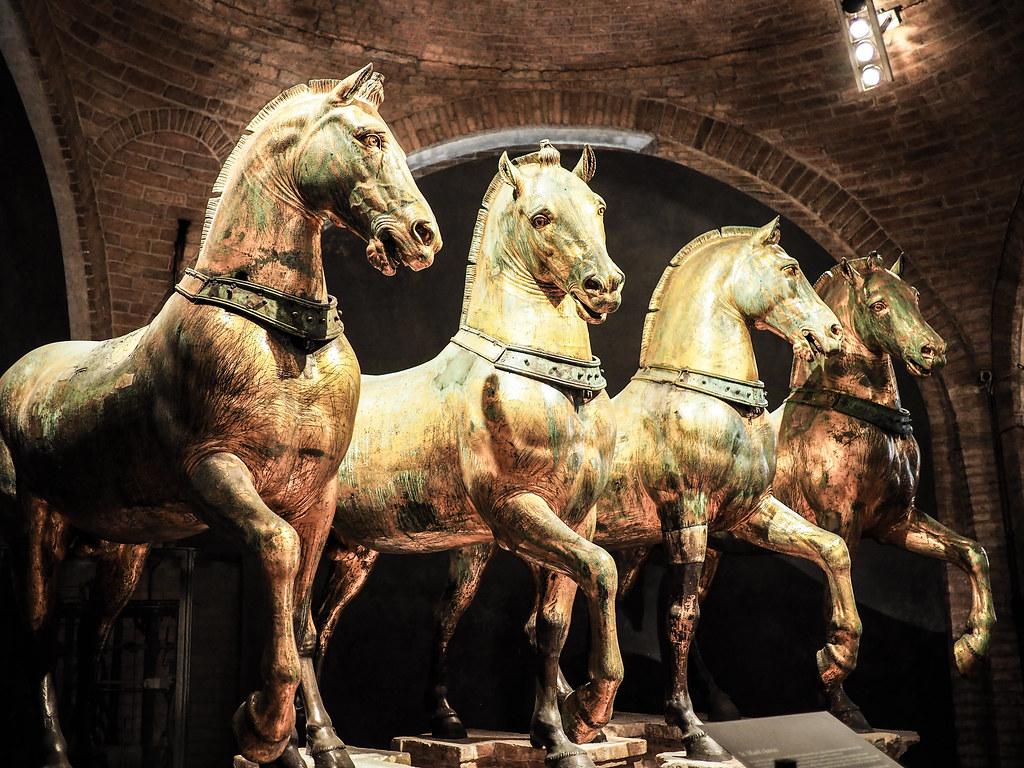
The Horses of Saint Mark, looted from Constantinople by the Venetians
How Ancient is Classical Greece?However, for the West, and Italy in particular, the sack of Constantinople kicked off an astounding economic growth, fed initially by the vast quantities of plundered gold. In the early thirteenth century the first gold coins appeared in the West, where only silver coinage had been issued so far (except in Sicily and Spain).
[36] The cultural benefits of the Fourth Crusade were also impressive: in subsequent years, whole libraries were pillaged, which Greek-speaking scholars would then start to translate into Latin. It can be said without exaggeration that the rise of humanism in Italy was an indirect effect of the fall of Constantinople.
The Council of Florence in 1438, the last attempt to reunite the Catholic and Orthodox churches, is an important date in the transfer of Greek culture to the West. Byzantine Emperor John VIII Paleologus and the Patriarch Joseph II came to Florence with a retinue of 700 Greeks and an extraordinary collection of classical books yet unknown in the West, including manuscripts of Plato, Aristotle, Plutarch, Euclid, and Ptolemy. “Culturally, the transmission of classical texts, ideas, and art objects from east to west that took place at the Council was to have a decisive effect on the art and scholarship of late 15th-century Italy.”
[37] And when, after 1453, the last bearers of Constantinople’s high culture fled Ottoman rule, many came to contribute to the blooming of the Italian Renaissance. In 1463, the Florentine court of Cosimo de’ Medici made acquaintance with the Neoplatonic philosopher George Gemistos, known as Pletho, whose discourses upon Plato so fascinated them that they decided to refound Plato’s Academy in Florence.
[38] They named Marsilio Ficino as its head, supplying him with Greek manuscripts of Plato’s work, whereupon Ficino started translating the entire corpus into Latin.
At the same time as they appropriated the Greek heritage, the Italian humanists affected to ignore their debt to Constantinople. As a result, until very recently, medieval studies overlooked the Byzantine influence on the West, and even the importance of the Byzantine Empire in the Middle Ages. Cambridge professor Paul Stephenson commented in 1972: “The excision of Byzantine history from medieval European studies does indeed seem to me an unforgivable offense against the very spirit of history.”
[39] One aggravating factor is that “practically all the archives of the imperial and patriarchal chanceries of Byzantium perished either in 1204, when the city was sacked by the Crusaders, or in 1453, when it fell under the Turks.”
[40] Byzantium was killed twice: after sacking it in 1204, the Latin West strove to erase it from its collective memory. As Steven Runciman writes:
“Western Europe, with ancestral memories of jealousy of Byzantine civilization, with its spiritual advisers denouncing the Orthodox as sinful schismatics, and with a haunting sense of guilt that it had failed the city at the end, chose to forget about Byzantium. It could not forget the debt that it owed to the Greeks; but it saw the debt as being owed only to the Classical age.”
[41]
It must be emphasized, however, that at this stage, scholars did not possess a consistent global chronology to date precisely the Greek classical age; that would be a project of the Jesuits in the sixteenth century, as we will document in the next article. French byzantinist Michel Kaplan makes the interesting remark that Western humanists who studied the Greek literature imported from Constantinople from the fourteenth century, “did not distinguish between the works of classical and Hellenistic Greece and those of the Byzantine era.”
[42] The implicit assumption is that modern scholars are now able to clearly make that distinction. But are they really?
The same questions we have raised about Latin sources in our earlier piece can be applied to Greek sources. What proof do we have that the works ascribed to Plato, for instance, date from about 2500 years ago? It has been solidly established that all of Plato’s known manuscripts derive from a unique archetype, dated from the period of the great Patriarch
Photios (c. 810-895). It was at that time that Byzantine emperor Leo the Philosopher “rediscovered” and promoted knowledge of Plato, as well as of his disciples Porphyry, Iamblichus and Plotinus, whom we now call Neoplatonists and ascribe to seven centuries later than Plato. Then there is the linguistic issue: Greek scholars such as Roderick Saxey II of Ohio State University are puzzled by “how little the language had changed, even in well over three millennia.”
[43] According to Harvard professor Margaret Alexiou, “Homeric Greek is probably closer to demotic [modern Greek] than twelfth-century Middle English is to modern spoken English.”
[44] If we assume that the evolution of languages follows universal laws, Homeric Greek should not be much older than Middle English.
In his stimulating book stimulating book
Re-Dating Ancient Greece, Sylvain Tristan explores how the Franks who ruled much of Greece after the Fourth Crusade, may have contributed not only to the transmission of classical Greek culture to the West, but to its elaboration.
[45] Tristan also notes that the architectural vestiges of Frankish Greece are not as easy to distinguish from those of the Classical Age as one would expect. On the Acropolis used to stand a tower known locally as the
Frankish Tower, probably built by Othon de la Roche, founder of the Duchy of Athens in the early thirteenth century. Although it was made of the same stones as the adjacent building, Heinrich Schliemann deemed it anachronistic and had it demolished in 1874.
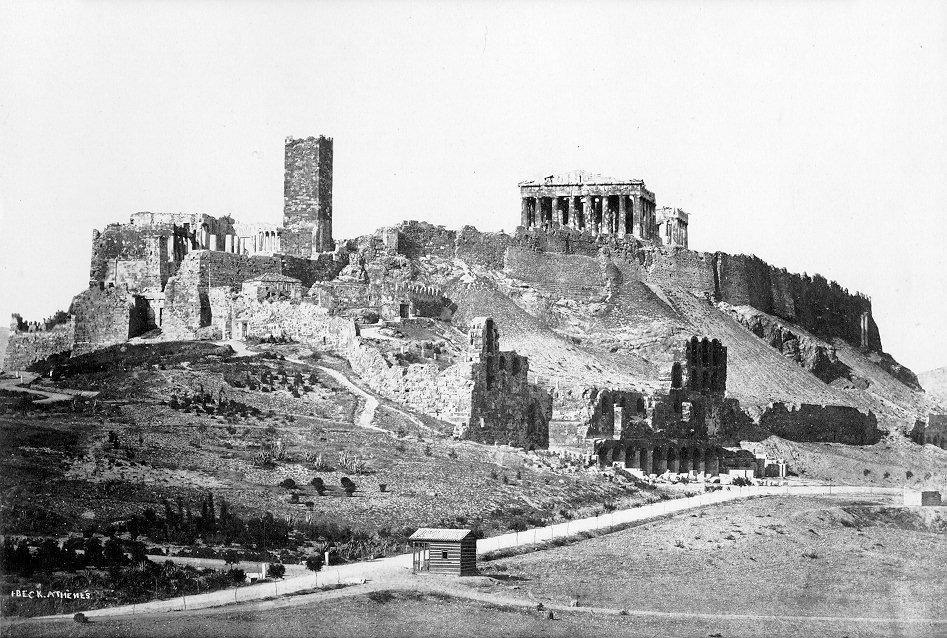
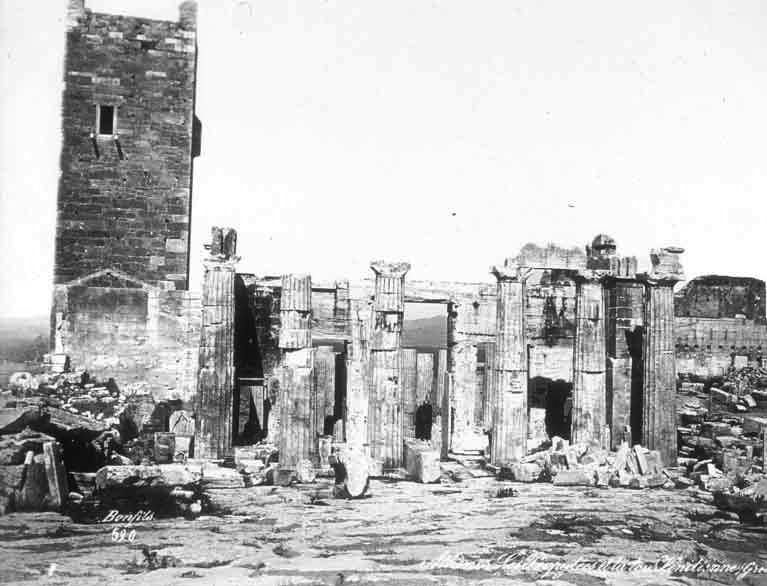
The Acropolis with its Frankish Tower in 1872
According to our textbook chronology, the Parthenon was built 2,500 years ago. Its current state may seem consistent with such old age, but few people know that it was still intact in 1687, when it was blown up by a bomb shot by a Venetian
mortar. The French painter Jacques Carrey had made some fifty-five drawings of it in 1674, which served later for its restoration.
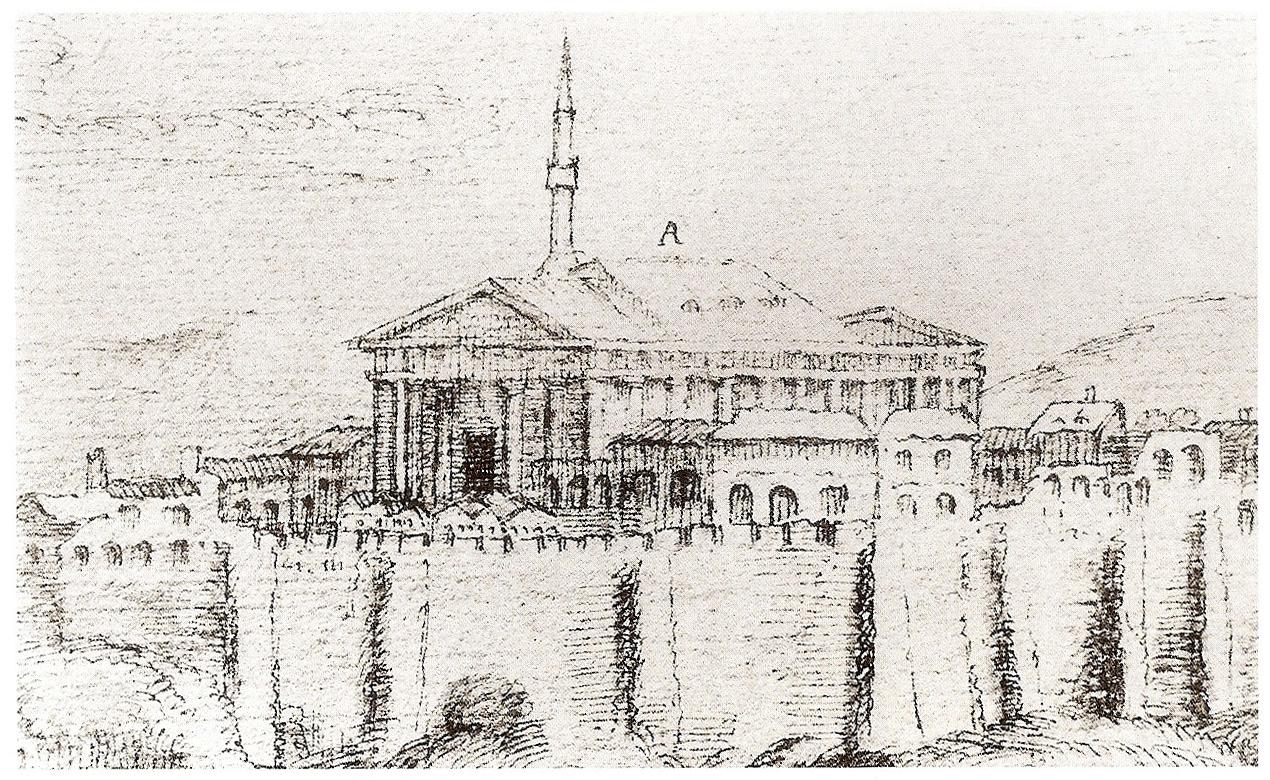
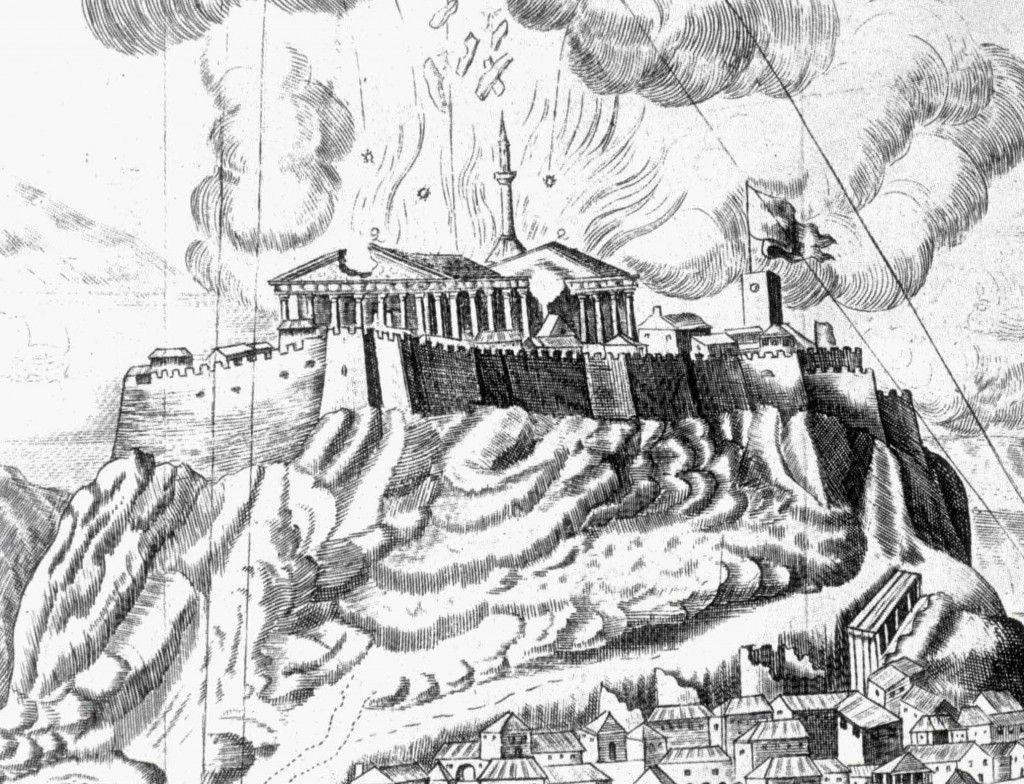
The Parthenon in 1674, and exploding in 1687
In ancient times, we are told, the Parthenon housed a gigantic statue of
Athena Parthenos (“Virgin”), while in the sixth century it became a church dedicated to “Our Lady or Athens,” until it was turned into a mosque by the Ottomans. Strangely enough, historian William Miller tells us in his
History of Frankish Greece that the Parthenon is not mentioned in medieval texts before around 1380, when the King of Aragon describes it as “the most precious jewel that exists in the world.” The Acropolis was then known as “the Castle of Athens.”
[46] Could it be a medieval fortified city from the start? Is Ancient Greece a fantasy? Or is it simply wrongly dated?
In the framework of our hypothesis that, between the eleventh and the fifteenth century, Rome invented or embellished its own Republican and Imperial Antiquity as propaganda to cheat Constantinople of its birthright, it makes sense that Rome would also invent or embellish a pre-byzantine Greek civilization as a way of explaining its own Greek heritage without acknowledging its debt to Constantinople. To explain how Greek culture had filled the world before reaching Rome, Alexander the Great and his Hellenistic legacy were also invented.
Alexander is a legendary figure. According to his most sober biography, due to Plutarch, at the age of 22, this Macedonian prince (educated by Aristotle) set out to conquer the world with about 30,000 men, founded seventy cities, and died at the age of 32, leaving a fully formed Greek-speaking civilization that stretched from Egypt to Persia. Sylvain Tristan remarks, after Anatoly Fomenko, that the Seleucids (Seleukidós), who ruled Asia Minor after Alexander, bear almost the same name as the Seljukids (Seljoukides) who controlled that same region from 1037 to 1194. Is the Hellenistic civilization another phantom image of the Byzantine commonwealth, pushed back in the distant past in order to conceal Italy’s debt to Constantinople? Such hypothesis seems farfetched. But it becomes plausible once we realize that our chronology is a relatively recent construction. In the Middle Ages, there existed no accepted long chronology scanning millenniums. If today Wikipedia tells us that Alexander the Great was born on July 21, 356 BC and died on June 11, 323 BC, it is simply because some sixteenth-century scholar declared it so, using arbitrary guesswork and a biblical measuring tape. However, with the recent progress of archeology, the problems met by our received chronology have accumulated into a critical mass.
Here is one example, mentioned by Sylvain Tristan: the “Antikythera mechanism” is an analogue computer composed of at least 30 meshing bronze gear wheels, used to predict astronomical positions and eclipses for calendar and astrological purposes decades in advance. It was retrieved from the sea in 1901 among wreckage from a shipwreck off the coast of the Greek island Antikythera. It is dated from the second or first century BC. According to
Wikipedia, “the knowledge of this technology was lost at some point in Antiquity” and “works with similar complexity did not appear again until the development of mechanical astronomical clocks in Europe in the fourteenth century.” This technological chasm of 1,500 years is perhaps easier to believe when one already believes that the heliocentric model developed by Greek astronomer Aristarchus of Samos in the third century BC was totally forgotten until Nicolaus Copernicus reinvented it in the sixteenth century AD. But skepticism is here less extravagant that the scholarly consensus.
The number of skeptics has grown in recent years, and several researchers have set out to challenge what they call the Scaligerian chronology (standardized by Joseph Scaliger in his book
De emendatione temporum, 1583). Most of these “recentists,” whom we will introduce in our next article, focus on the first millennium AD. They believe that it is much too long, in other words, that Antiquity is closer to us than we think. They actually find themselves in agreement with the Renaissance humanists who, according to historian Bernard Guenée, thought of the “middle age” between Antiquity and their time (the term
media tempestas first appears in 1469 in the correspondence of
Giovanni Andrea Bussi) as “nothing but a parenthesis, an in-between.”
[47] In 1439,
Flavio Biondo, the first archeologist of Rome, wrote a book about this period and titled it:
Decades of History from the Deterioration of the Roman Empire. Giorgio Vasari thought of it as a mere two centuries when he wrote in his
Life of Giotto (1550), that Giotto (1267-1337) “brought back to life the true art of painting, introducing the drawing from nature of living persons, which had not been practised for
two hundred years.”
[48]If our Middle Ages have been artificially stretched by seven or more centuries, does that mean that most of it is pure fiction? Not necessarily. Gunnar Heinsohn, using comparative archeology and stratigraphy (explore
his articles or watch his
video conference), argues that events spread throughout Antiquity, Late Antiquity and the Early Middle Ages were in fact contemporary. In other words, the Western Roman Empire, the Eastern (Byzantine) Roman Empire, and the Germanic Roman Empire must be resynchronized and seen as parts of the same civilization which collapsed a little more than ten centuries ago, after a global cataclysmic event that caused a commotion of memory and a taste for apocalyptic salvation cults.
Notes
[1] Claire Levasseur et Christophe Badel,
Atlas de l’Empire romain : Construction et apogée: 300 av. J.-C. – 200 apr. J.-C., Édiions Autrement, 2020
, p. 76.
[2] Most influential was Émile Littré with his
Histoire de la langue française, 1862.
[3] Angelo Mazzocco,
Linguistic Theories in Dante and the Humanists: Studies of Language and Intellectual History in Late Medieval and Early Renaissance Italy, E.J. Brill, 1993, p. 175 (read on books.google.com).
[4] In the words of Jerry Brotton,
The Renaissance Bazaar: From the Silk Road to Michelangelo, Oxford UP, 2010, p. 66, as already quoted in “How Fake is Roman Antiquity?”
[5] Jacques Heers,
Le Moyen Âge, une imposture, Perrin, 1992, pp. 55-58.
[6] Bart D. Ehrman,
Forgery and Counterforgery: The Use of Literary Deceit in Early Christian Polemics, Oxford University Press, 2013 (on books.google.com), pp. 1, 27.
[8] Herbert Edward John Cowdrey,
The Cluniacs and the Gregorian Reform, Clarendon, 1970.
[9] Marc Bloch,
Feudal Society, vol. 1:
The Growth of Ties of Dependance, University of Chicago Press, 1964, p. 107.
[10] Robert I. Moore,
The First European Revolution, c. 970-1215, Basil Blackwell, pp. 11, 174.
[11] Harold Berman,
Law and Revolution, the Formation of the Western Legal Tradition, Harvard UP, 1983, pp. 15, 108.
[12] Laurent Morelle, “Des faux par milliers”
L’Histoire, n° 372, February 2012.
[13] Reproduced from from F. Henderson, (Ed.),
Select Historical Documents of the Middle Ages, George Bell and Sons, 1910 (on archive.org), pp. 329-333.
[15] John Meyendorff and Aristeides Papadakis,
The Christian East and the Rise of the Papacy, St Vladimir’s Seminary Press, 1994, pp. 55, 167, 27.
[16] Aviad Kleinberg,
Histoires de saints. Leur rôle dans la formation de l’Occident, Gallimard, 2005, p. 72.
[17] Andrew J. Ekonomou,
Byzantine Rome and the Greek Popes: Eastern Influences on Rome and the Papacy from Gregory the Great to Zacharias, A.D. 590-752, Lexington Books, 2009, p. 43.
[18] Michel Kaplan,
Pourquoi Byzance ?: Un empire de onze siècles, Folio/Gallimard, 2016, p. 55.
[19] Robert Favreau, Bernadette Mora and Jean Michaud, “Chrismes du Sud-Ouest,” CNRS Editions, 1985 (
Corpus des inscriptions de la France médiévale, 10), on
www.persee.fr [21] Edwin Johnson,
The Rise of Christendom (1890)
, on archive.org, p. 360.
[22] Edwin Johnson,
The Rise of Christendom, op. cit., p. 50.
[23] Edwin Johnson,
The Rise of Christendom, op. cit., pp. 7, 80.
[24] James Watson,
Interpolations in Bede’s Ecclesiastical history and other ancient annals affecting the early history of Scotland and Ireland, Peebles, 1883 (archive.org), p. 9.
[25] Grégroire de Tours,
Histoire des rois francs, Gallimard, 1990, chapitre IV, p. 103
[26] Raoul Glaber,
Histoires, éd. et trad. Mathieu Arnoux, Turnhout, Brépols, 1996, IV, §13, pp. 163-165.
[27] Thomas Creissen, “La christianisation des lieux de culte païens : ‘assassinat’, simple récupération ou mythe historiographique ?”,
Gallia – Archéologie de la France antique, CNRS Éditions, 2014, 71 (1), pp. 279-287, on hal.archives-ouvertes.fr
[28] Polydor Hochart,
De l’authenticité des Annales et des Histoires de Tacite, 1890 (on archive.org), pp. 3-5.
[29] Sylvain Gouguenheim,
Aristote au Mont Saint-Michel. Les racines grecques de l’Europe chrétienne, Seuil, 2008.
[30] Einar Joranson, “The Problem of the Spurious Letter of Emperor Alexis to the count of Flanders,”
The American Historical Review, vol. 55 n°4 (July 1950), pp. 811-832, on
www.jstor.org. [31] Jonathan Harris,
Byzantium and the Crusades, Hambledon Continuum, 2003, p. 56.
[32] Robert de Clari,
La Conquête de Constantinople, Champion Classiques, 2004, p. 171.
[33] Steven Runciman,
A History of the Crusades, vol. 3:
The Kingdom of Acre and the Later Crusades (1954), Penguin Classics, 2016, p. 123.
[34] Jonathan Harris,
Byzantium and the Crusades, op. cit., p. 50.
[35] Steven Runciman,
A History of the Crusades, vol. 3,
op. cit, p. 130.
[36] Edwin Hunt,
The Medieval Super-Companies: A Study of the Peruzzi Company of Florence, Cambridge UP, 1994.
[37] Jerry Brotton,
The Renaissance Bazaar: From the Silk Road to Michelangelo, Oxford UP, 2010, p. 103.
[38] In his book
Re-Dating Ancient Greece (2008), Sylvain Tristan points to intriguing paralells between Plato’s and Pletho’s lives, and makes the hypothesis that Plato is in reality a fictional personae of Pletho.
[39] Paul Stephenson,
The Byzantine World, Routledge, 2012, p. xxi.
[40] John Meyendorff,
Byzantium and the Rise of Russia, Cambridge UP, 1981, p. 2.
[41] Steven Runciman,
The Fall of Constantinople 1453, Cambridge UP, 1965, p. 190.
[42] Michel Kaplan,
Pourquoi Byzance? Un empire de onze siècles, Folio/Gallimard, 2016, p. 39.
[44] Margaret Alexiou, “Diglossia in Greece,” in William Haas,
Standard Languages: Spoken and Written, Manchester UP, 1982.
[45] Sylvain Tristan,
Re-Dating Ancient Greece: 500 BC = 1300 AD?, independently published, 2008.
[46] William Miller,
The Latins in the Levant: A History of Frankish Greece (1204-1566), P. Dutton & Co., 1908 (on archive.org), pp. 315, 327.
[47] Bernard Guenée,
Histoire et culture historique dans l’occident medieval, Aubier, 2011, p. 9.
[48] David Carrette,
L’Invention du Moyen Âge. La plus grande falsification de l’histoire, Magazine
Top-Secret, Hors-série n°9, 2014, pp. 43, 53.